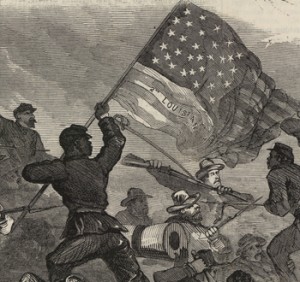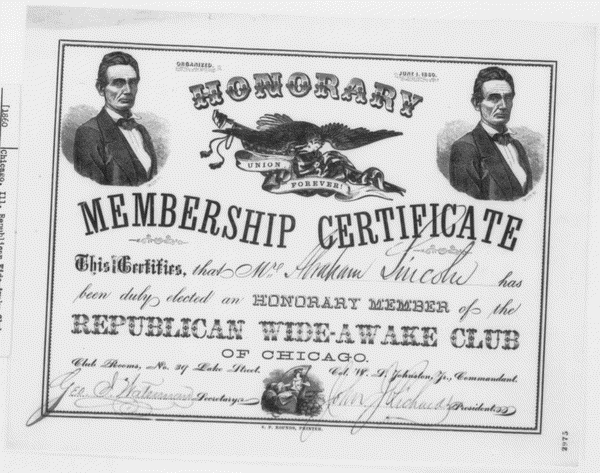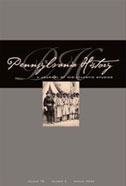Watch a short slideshow or take a look at these images related to the United States Colored Troops (USCT). All of these images are from the Library of Congress Prints & Photographs Division.
26
Apr
10
USCT Slideshow
Posted by sailerd Published in Civil War (1861-1865), Images Themes: Battles & Soldiers23
Apr
10
Presentation of Colors to the 20th USCT
Posted by sailerd Published in Civil War (1861-1865), Historic Periodicals Themes: Battles & SoldiersAs USCT regiments were organized in northern states, they were often honored at ceremonies held in local cities or at their training camps. A previous post described a flag raising ceremony at Camp William Penn. This article in Frank Leslie’s Illustrated Newspaper, however, described the event at which the 20th USCT received their colors in New York City. “A vast crowd of citizens of every shade of color, and every phase of social and political life, filled the square, and streets, and every door, window, veranda, tree and housetop that commanded a view of the scene was peopled with spectators,” as the reporter observed. You can read the entire article here.
21
Apr
10
Voting Rights and the Grand Review (Nov. 1865)
Posted by sailerd Published in Civil War (1861-1865), Recent Scholarship Themes: Battles & SoldiersWhile Gerald G. Eggert’s article in Pennsylvania History focuses on the experiences of Harrisburg’s African American community throughout a century, it also includes a short but interesting description of Harrisburg’s Grand Review in November 1865. The parade in Harrisburg was clearly an opportunity for that community to honor the African Americans who served in the USCT during the Civil War. Yet the Grand Review’s organizers had other important objectives as well. “These leaders hoped to use the occasion to build support for extending the suffrage once more to blacks,” as Eggert observes. African American men in Pennsylvania, however, were not able to vote until the 15th Amendment was adopted in 1870. Pennsylvania History, which is the official journal of the Pennsylvania Historical Association, is available through a digital archive that contains all of the issues published between 1934 and 2005. Eggert’s article is available here as PDF file – see page 16 for Eggert’s description of the Grand Review. (Note that Adobe Reader has to be installed on your computer in order to read this article.)
21
Apr
10
Civil War Letters of John C. Brock
Posted by Published in Civil War (1861-1865), Letters & Diaries, Recent Scholarship Themes: Battles & SoldiersThe book Making and Remaking Pennsylvania’s Civil War is a collection of essays about the events and legacies of the Civil War in Pennsylvania. The essay “The Civil War Letters of Quartermaster Sergeant John C. Brock, 43rd Regiment, United States Colored Troops,” edited by Eric Ledell Smith, focuses specifically on the issue of African-American troops from Pennsylvania. The first part of the chapter contains a synthesis of the history of African-American troops during the Civil War in general and specifically in Pennsylvania. The second part contains nine letters written by John C. Brock to the Christian Recorder, a newspaper published in Philadelphia by the African Methodist Church. Smith gives a good biography of Brock and explains the context and background of each letter. John C. Brock was born in Carlisle, Pennsylvania in 1843, and he enlisted in the army at Camp William Penn in April 1864. One of the exceptions to the general rule of not assigning colored regiments to combat duty, the 43rd regiment arrived in Virginia as part of the rear guard to the Army of the Potomac and Brock shared, “You cannot imagine with what surprise the inhabitants of the South gaze upon us.” Later, when his regiment proudly passed through Fairfax, Virginia “armed to the teeth, with bayonets bristling in the sun,” Brock echoed the same sentiment: , “The inhabitants… looked at us with astonishment, as if we were some great monsters risen up out of the ground.” His letters cover a wide range of topics, from religion to food and supplies to other African-American troops from Pennsylvania. Unfortunately, although his regiment was present at the Battle of the Crater, Brock does not mention it in his letters, and he also rarely elaborates on the issue of slavery, instead choosing to focus on topics more relevant to his everyday life in the army. His last letter in March 1865 briefly broaches the topic with eloquence and a great deal of optimism: “The hydra-headed monster slavery which, a few short years ago, stalked over the land with proud and gigantic strides, we now behold drooping and dying under the scourging lash of universal freedom…. The bondmen of the South have heard that single word ‘liberty,’ and they will not heed the siren voice of their humbled masters.” Brock is clearly proud to have had a part in defeating the South and the institution of slavery. These letters are a valuable resource for studying the Civil War from a perspective that is often overlooked, that of an African-American soldier in combat duty.
20
Apr
10
3rd USCT Regiment
Posted by sailerd Published in Civil War (1861-1865), Rare Books Themes: Battles & Soldiers The 3rd USCT Regiment, which was organized in August 1863, was the first unit to receive training at Camp William Penn, located outside of Philadelphia. (You can read about this regiment’s flag raising ceremony in a previous post). The War Department initially sent this regiment to South Carolina, where it was involved in the campaign to seize Fort Wagner:
The 3rd USCT Regiment, which was organized in August 1863, was the first unit to receive training at Camp William Penn, located outside of Philadelphia. (You can read about this regiment’s flag raising ceremony in a previous post). The War Department initially sent this regiment to South Carolina, where it was involved in the campaign to seize Fort Wagner:
- “Soon after its organization, the Third was ordered to the Department of the South and proceeded thither, arriving at Morris Island while the siege of Fort Wagner was in full progress. It was immediately put into the trenches, and shared in the hardships of that memorable trial of skill and endurance which resulted in the fall of the fort. The loss during this siege was six killed and twelve wounded. In one of the night attacks which resulted in the capture of a line of rifle pits, a Corporal was reported missing. Two days after, the advance sappers came upon his dead body. Warned by previous experience, they were careful to examine it thoroughly before attempting to remove it. A small string was discovered attached to its leg, which led away to the trigger of a torpedo buried in the sand. Such was the warfare which this command was called to meet.”
This regiment was sent to Florida in early 1864 and remained there until it was disbanded in October 1865. The full summary of the 3rd USCT Regiment’s actions during the Civil War and the complete muster roll is available through Google Books in volume five of Samuel P. Bates, History of Pennsylvania Volunteers, 1861-5 (1871).
12
Apr
10
Battle of Port Hudson (May 1863)
Posted by sailerd Published in Civil War (1861-1865), Historic Periodicals, Images Themes: Battles & Soldiers The Battle of Port Hudson on May 27, 1863 did not include USCT regiments organized in Pennsylvania, but it was among the first major engagements of the Civil War that involved African American regiments. The Union’s efforts in late May 1863 failed to capture Port Hudson, Louisiana, which in turn led to a siege that ended on July 9 when the Confederates surrendered. Yet even though the initial attack had failed, the African American regiments’ actions during that battle were singled out as particularly noteworthy. Union General Nathaniel P. Banks noted in his official report that “[the men’s] conduct was heroric” and that “no troops could be more determined or more daring.” In one day “they made…three charges upon the batteries of the enemy, suffering very heavy losses, and [held] their positions at nightfall with the other troops,” as Banks explained. Frank Leslie’s Illustrated Newspaper published Banks’ report along with a poem written by a Philadelphia poet. Some northerners questioned whether USCT regiments would be effective against Confederate forces, but this battle and others provided irrefutable evidence as to how wrong their original assumptions had been. “We may be sure” that those regiments, “after Port Hudson, [will not] be again exposed to sneers or insult,” as a Harper’s Weekly editorial concluded.
The Battle of Port Hudson on May 27, 1863 did not include USCT regiments organized in Pennsylvania, but it was among the first major engagements of the Civil War that involved African American regiments. The Union’s efforts in late May 1863 failed to capture Port Hudson, Louisiana, which in turn led to a siege that ended on July 9 when the Confederates surrendered. Yet even though the initial attack had failed, the African American regiments’ actions during that battle were singled out as particularly noteworthy. Union General Nathaniel P. Banks noted in his official report that “[the men’s] conduct was heroric” and that “no troops could be more determined or more daring.” In one day “they made…three charges upon the batteries of the enemy, suffering very heavy losses, and [held] their positions at nightfall with the other troops,” as Banks explained. Frank Leslie’s Illustrated Newspaper published Banks’ report along with a poem written by a Philadelphia poet. Some northerners questioned whether USCT regiments would be effective against Confederate forces, but this battle and others provided irrefutable evidence as to how wrong their original assumptions had been. “We may be sure” that those regiments, “after Port Hudson, [will not] be again exposed to sneers or insult,” as a Harper’s Weekly editorial concluded.
See images related to this event in the Slideshow below –
6
Apr
10
Abraham Lincoln in 1860 at the Library of Congress
Posted by Published in Antebellum (1840-1861), Images, Lesson Plans, Letters & Diaries Themes: Contests & Elections The Library of Congress provides a wealth of resources for teachers to use in the classroom. Most helpful are the themed Collection Connections, which seek to give historical context to the Library’s collections and assist teachers in using them in the classroom. One of these Collection Connections is on the Abraham Lincoln papers. In this section, documents by Abraham Lincoln have been selected for each of several categories. These resources are invaluable for anyone studying the life and times of Abraham Lincoln. One of the categories is Lincoln’s 1860 presidential campaign. There are four key documents included to illustrate this period of Lincoln’s life, including speech notes, campaign posters, and a letter. This selection of a few key documents serves to underscore the main themes and events of the campaign, and there are discussion questions included as well for teachers to use in the classroom. The page presents the information in a clear way but requires a critical reading of the texts as well. To help students further analyze the documents, there is a critical thinking page designed to give assistance with interpretation and analysis of events during Abraham Lincoln’s lifetime.
The Library of Congress provides a wealth of resources for teachers to use in the classroom. Most helpful are the themed Collection Connections, which seek to give historical context to the Library’s collections and assist teachers in using them in the classroom. One of these Collection Connections is on the Abraham Lincoln papers. In this section, documents by Abraham Lincoln have been selected for each of several categories. These resources are invaluable for anyone studying the life and times of Abraham Lincoln. One of the categories is Lincoln’s 1860 presidential campaign. There are four key documents included to illustrate this period of Lincoln’s life, including speech notes, campaign posters, and a letter. This selection of a few key documents serves to underscore the main themes and events of the campaign, and there are discussion questions included as well for teachers to use in the classroom. The page presents the information in a clear way but requires a critical reading of the texts as well. To help students further analyze the documents, there is a critical thinking page designed to give assistance with interpretation and analysis of events during Abraham Lincoln’s lifetime.
5
Apr
10
USCT at the Battle of Milliken’s Bend (June 7, 1863)
Posted by sailerd Published in Civil War (1861-1865), Historic Periodicals Themes: Battles & Soldiers The Battle of Milliken’s Bend on June 7, 1863 was only a small part of the Vicksburg Campaign, but this engagement represented another important moment for African American participation in the Civil War. The three African American regiments, which had just been organized during the previous month, played an important part in the Confederate forces defeat. Victory, however, came at a high cost for those three regiments – almost 8% of the men who participated were killed. Yet as historian Richard Lowe observes, this battle “loom[ed] large in the overall history of the Civil War.” Even Confederates recognized the significance. “The obstinacy with which they fought…open the eyes of the Confederacy to the consequences” of the decision to allow African Americans to fight, as Confederate General John G. Walker recalled. Reports about the battle were published in newspapers across the country. While “at first [they] gave way,” the Frank Leslie’s Illustrated Newspaper made sure to note in their short summary that “the colored troops…[saw] their wounded massacred, rallied, and after one of the most deadly encounters in the war, drove the rebels back.” A letter published in Harper’s Weekly offered a similar account: “It was a genuine bayonet charge, a hand-to-hand fight, that has never occurred to any extent during this prolonged conflict.”
The Battle of Milliken’s Bend on June 7, 1863 was only a small part of the Vicksburg Campaign, but this engagement represented another important moment for African American participation in the Civil War. The three African American regiments, which had just been organized during the previous month, played an important part in the Confederate forces defeat. Victory, however, came at a high cost for those three regiments – almost 8% of the men who participated were killed. Yet as historian Richard Lowe observes, this battle “loom[ed] large in the overall history of the Civil War.” Even Confederates recognized the significance. “The obstinacy with which they fought…open the eyes of the Confederacy to the consequences” of the decision to allow African Americans to fight, as Confederate General John G. Walker recalled. Reports about the battle were published in newspapers across the country. While “at first [they] gave way,” the Frank Leslie’s Illustrated Newspaper made sure to note in their short summary that “the colored troops…[saw] their wounded massacred, rallied, and after one of the most deadly encounters in the war, drove the rebels back.” A letter published in Harper’s Weekly offered a similar account: “It was a genuine bayonet charge, a hand-to-hand fight, that has never occurred to any extent during this prolonged conflict.”
2
Apr
10
“Flag Raising at Camp William Penn”
Posted by sailerd Published in Civil War (1861-1865), Historic Periodicals Themes: Battles & Soldiers This report appeared in the Boston Liberator in August 1863 and described the ceremony for the 3rd USCT regiment that took place at Camp William Penn. Even though this regiment was organized in “a comparatively short time,” the reporter believed that the men “[had] evinced a degree of enthusiasm and discipline that would do credit to older troops.” After a regiment drill “in which every evolution…was characterized by military correctness,” several speakers addressed the crowd. One noted that while “your enemies have said you would not fight,” the USCT “[has] already shown how base was that charge.” Another observed that in “this…war for freedom,” the 3rd USCT regiment “[would be] among the grandest of its soldiers.” You can read the entire article here.
This report appeared in the Boston Liberator in August 1863 and described the ceremony for the 3rd USCT regiment that took place at Camp William Penn. Even though this regiment was organized in “a comparatively short time,” the reporter believed that the men “[had] evinced a degree of enthusiasm and discipline that would do credit to older troops.” After a regiment drill “in which every evolution…was characterized by military correctness,” several speakers addressed the crowd. One noted that while “your enemies have said you would not fight,” the USCT “[has] already shown how base was that charge.” Another observed that in “this…war for freedom,” the 3rd USCT regiment “[would be] among the grandest of its soldiers.” You can read the entire article here.
26
Mar
10
Captain Noah Hart Papers (1862-1865)
Posted by sailerd Published in Civil War (1861-1865), Historic Periodicals, Images, Letters & Diaries Themes: Battles & SoldiersThe Noah Heart Papers at Dominican University offer an interesting perspective on the Civil War from a Union officer. Noah, who served with the 10th Michigan Infantry, wrote a number of letters to his wife, Emily, between 1862 and 1865. His regiment took part in several campaigns, including General William T. Sherman’s March to the Sea. While outside Atlanta in August 1864, Noah described one of the problems with his regiment’s supply chain. The 10th Michigan Infantry “lines of communication..are of immense length already,” and as Noah observed, “the farther we penetrate into the enemies country the more they become exposed.” “[If [the Confederates] should cut off our Cracker and Bacon line,” Noah concluded that “we would be in a pretty fix.” This collection also includes Noah’s military records, parts of Noah’s diary, newspaper clippings related to the Hart family (such as Noah’s obituary), and several photographs.





















